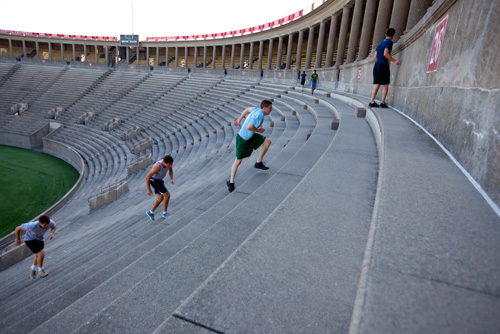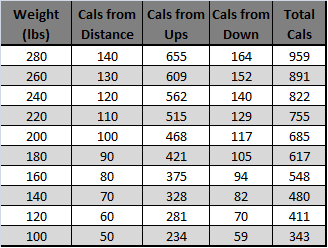Harvard Stadium. For decades, masochistic people with a desire to be extremely fit have run up the "seats" of Harvard Stadium. The November Project was pretty much born there. Some Harvard varsity athletes run it for extra endurance training. People bring their dogs, but it's so difficult the dogs say, "screw this noise" and go lie down. It's a beast of a run. You want ripped abs? Abs are made in the kitchen, eat less calories than you expend in a day. Want to earn a few extra calories? Run a stadium. Abs can also be made at the stadium.

Harvard Students running the Stadium. Source.
Current articles suggest a normal 180 lbs. person will expend 9 calories per minute while doing stairs. We are not normal people. We are beasts. We are animals. Metrics for mere humans aren't for us. Let's do a serious math review so we know exactly how wrong this number is.
At the end I point out why stadiums are far better than running, even if they burn similar calories. As usual, skip to the end to read the important parts if you don't like details.
Maths!
1. Each stadium "step" is 15 inches, or about 0.38 meters.
2. There are 31 steps per section. If you don't cheat, that is. Most people cheat and skip the bottom-most and top-most one because they aren't wide. If you skip both of these, you are eliminating 74 whole steps, or 2.3 whole sections. This is nearly 7% of the workout. You are depriving the world of 7% of the exercise that's supposed to make you beautifully buff. Run all the steps.
3. There are 37 sections.
4. Each step traverses 30 inches horizontally.
5. We are using my weight. Last weigh-in I was 215 lbs, or slightly less than 100kg (it's 98, but much like 5' 10" people like to say they are 6' tall, I like to say I am 100kg). There is a chart at the bottom to adjust for other weights.
Part 1: Going Up!

Hokay, so, 37 sections will net you 437m of vertical distance. Now it's time to figure out how much energy this is! We use the standard mass*gravity*height for this, using my mass. I'm aware that not everyone is a 100kg monster, so we'll have a scale farther on down.

Remember that 1 calorie equals 4.18 joules, but the calories we talk about with weight gain, etc., are actually kilocalories. So we have 430kj, and we need kilocalories.

103 (kilo)calories?!? "Oh no!" you say, "I do all that work and only burn 103 calories? What a waste!" Now hold up there a second, we aren't done yet. We can assume a roughly 20% efficiency of turning our food into work output. So let's multiply this by 5.

So for a 100kg fatty like myself, the vertical distance alone from doing one stadium is about 515 calories.
The flats!
I measured the flat areas to be 30 inches, or about 0.762m. How far is an entire stadium? Well, first, we need to state that one of those 31 steps isn't traversed, cause it's the last step and we only do the vertical part before going back down. So we have 30 stairs per section that we move on the horizontal part of.

Let's include the distance around the stadium, which we know to be about 250-300 meters (100 yard field + out of bounds areas traversed twice plus the 75 or so yards for the width plus out-of-bounds). So let's guess here and just call it 1100m, or 1.1km.
A 100kg man burns about 100 calories per km. See how well the metric system works? So I burn 110 calories doing the horizontal section of the steps (ie going forward as I go up)
We are now at 625 calories for 100kg person running a stadium, 515 from going up, and 110 from going forward.
Stepping Down
Okay. This is complicated. We are going to take a mulligan here and reference a pubmed medical journal article. That's right, when I mulligan, it's by referencing peer-reviewed science.
This particular article says going down steps takes roughly 1/3 the energy as going up them. Let's be a bit more conservative and assume we are in better shape than the average person, and say it takes 1/4 the energy. This might be false, but I'd rather come in slightly modest than slightly exaggerating when it comes to my calorie expenditure on a stadium.
515 calories for a 100kg man going up the stadium steps. One quarter of this is about 130 calories.
Summing It All Up, and Burn Rate

Okay, that's a lot. Now on a good day, I run the stadium in 35 minutes (yes, I'm slow, but I'm also 100kg. Also I'm recovering from whooping cough and a sprained knee, so right now I'm at more like 45 minutes). My average burn rate is 21 calories per minute. Compared to an estimated 9-11 for a normal person taking the stairs. So pretty much you're doubling the work rate of a normal person doing normal steps.
Comparison to Running:
To burn 750 calories from running, I need to run 7.5km. This is 4.66 miles. To have an equal calorie burn-rate, I need to run 7.5 minute miles. Which is easy for me.
In other words, I burn as many calories by running on the flat ground as I do on the stadium.
In fact, running is much easier for me than the stadium. Are we missing something? Probably. While doing stadiums, you are using far more muscle groups that while running, and you are likely engaging a lot more core. In other words, the numbers I've calculated here are a pure energetic viewpoint. It doesn't account for wasted energy/motion that is much more likely in the uphill push that is a stadium. Finally, stadiums actually work your muscles. Running, less so.
So What? The Difference Lay in the Details
Hokay. So. Stadium vs. running. Both burn calories. But where do these calories come from? Turns out when you do resistance training, IE take stadium steps, you are working your muscles a lot more than endurance training.
This is important. If you are trying to lean out, IE lose fat, running doesn't do a great job. When running, you are likely to lose muscle mass to produce some of those calories, or to burn them muscles afterwards when your body is starved for energy. When doing stadiums, you need those muscles, and your body preserves them.
This isn't random bullshit. There are solid scientific studies that show that a diet + resistance training (stadiums, lifting) results in loss of fat, but a diet + endurance (running) results in loss of fat and muscle. In other words, run all you want, but you're just gonna make yourself skinny fat. If you want to look good naked, you have to push iron, do body weight exercises, sprint, and/or do stadiums and hills.
Short story: you want abs for the summer? Run stadiums, lift weights, watch your calories.
More Times and Maths!
Here the math works out pretty well. If you run a 35 minute stadium, you have to run 5 miles in 35 minutes for equal calorie burn, or 7 minute miles. So a 30 minute stadium means 6 minute miles for 30 minutes, and a 25 minute stadium means 5 minute miles for 25 minutes for equal calories. Here is where the difference is. The fittest people I know can't run a 5 minute mile, much less five in a rown, but they can easily run 25 minute stadiums. Thanks for Adnan Khera for making me think about it that way!
Charts!
Okay, as promised, here is a chart for stadiums and calories burnt! Remember, these are probably an under-estimate!
For Normal Sized People
Now for some handy-dandy charts!
Now, why did I leave off people under 100 lbs.? Cause no one under 100 lbs should be counting calories. They are either children or need to eat several more sandwiches. And why would I go up to 280? Cause Harvard football runs this thing, and many of those guys make me look tiny.
That's all. Thanks for reading!
- Jason Munster


I'm a huge fan of Harvard stairs - this is an amazingly thorough analysis! No doubt there are huge benefits to the workout. Do you realize, though, that the study you link to puts stair climbing in the control group that lost lean body weight, not the "resistance training" group that preserved it? Maybe Harvard is more resistance-oriented by virtue of being harder than regular stairs.
Since it was alongside walking as an endurance exercise in the study, I assumed the "stairs" mentioned in the article was the type where you don't bend your leg and take them at a slow pace, as opposed to the stadium where most people get a nearly 90 degree bend that simulates more of a body-weight squat (or 1100 body weight squats for an entire tour). It could be an erroneous assumption, but given the post-stadium level of soreness indicating muscle microtears (the precursor to hypertrophy), I think it's a fairly safe assumption, even if the limiting factor on stadiums tends to be respiration rate. To me, the stadium is part application of "lifting weights faster" for cardio while doing resistance, and part endurance.
I'm pretty sure—and will measure tomorrow—that the stairs are 18" high each. I measured with my hands but by hands ate 9", and the stairs are two hands high.
I went to the stadium with a tape measure and measured it for the article 🙂
Why did you refer to the "seats" as "stairs"? More accurate to say that one runs up the seats, and walks down the stairs. BTW: I gave up running up the SEATS and just run up the STAIRS, then down the same set of stairs, then over to the next set of stairs. The seats are too annoying to me! Thx for the hard work and math tho. Nice job.
Thanks for writing this article... It's excellent! As a 5'4" woman, I find the stadiums to be a significantly challenging work out, and I think the steps grow a little taller as I get closer to the top. 🙂 I'm an avid ultimate frisbee player, so I run them for cross training and to (hopefully) increase my explosive power on the ground and in the air. Hopefully they work, otherwise I'm just a glutton for punishment!
Thanks for this! I run the stadiums for the HIIT portion of my off-season training. I'm a lightweight sculler. I don't concern myself with the calories; i do this for conditioning. I am psyched to learn that my weekly stadium run has the metabolic equivalent of running a 30 min 10K (something I've never achieved while running in a 10K road race...) This has just reinvigorated my motivation for my weekly stadium run!
Haha, this rocks, especially since I'm 180 pounds and was google how many calories I could burn running the stadium. Going to run it now!
Article was great. I tried it last week and it was a really challenging workout. Due to the number of steps running up one section is clearly more than one flight of stairs. Does anyone know what the equivalent flight of stairs is?
Hi Tom. In many states, a maximum length for a flight of stairs is 12 feet. So 8 stadium seats is the largest legal definition of a flight. At 31 seat-steps per section, there are a minimum of 4 flights of stairs per section.